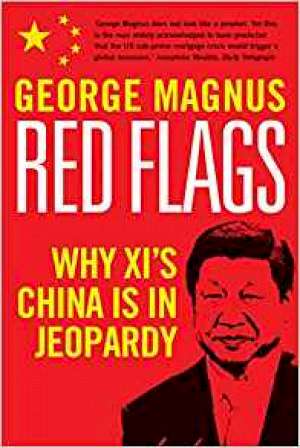20 November 2018
Red Flags
Why Xi’s China Is In Jeopardy
George Magnus
2018, Yale University Press, 248 pages,
ISBN 9780300233193
Reviewer: Keith Wade, Chief Economist, Schroders

China has reached a critical point in its development. The gains from past reforms have played out and the economy faces significant challenges if it is to raise income levels to those of the advanced economies.
The boost from World Trade Organisation (WTO) membership, which catapulted China to the top of the world’s export league, has begun to fade as new low-cost competitors emerge and global trade struggles to regain the vigour experienced prior to the global financial crisis (GFC). Meanwhile the productivity benefits associated with moving workers from agriculture to industry have begun to ebb as the process nears completion. Finally, the demographic dividend from an expanding workforce has gone into reverse as China ages.
If that were not enough, China has run up a debt to GDP ratio of more than 300%, high by any standards, but especially so for an economy at this stage of development. And, of course, President Trump is threatening to send some of those WTO gains into reverse as he embarks on a trade war with China.
In this excellent book George Magnus lucidly describes these challenges as a series of traps – the red flags – which could trip China up and prevent her realising her “dream of the great rejuvenation of the Chinese nation”. Essentially, the red flags make it harder for China to escape the well documented middle-income trap where a developing economy becomes unable to maintain rising prosperity and becomes stuck with income levels well below those of the advanced economies. As Magnus notes, this has proven to be a considerable challenge with only 13 of the 101 countries classified as middle income in 1960 becoming high income countries today.
Going forward the demographic trap means that the only way an economy with a contracting working population can escape the middle-income trap is through an increase in total factor productivity – the gains from combining factors of production capital and labour more efficiently. Simply investing more capital is not sufficient: China has already found that the marginal output gains from investment have become smaller and smaller – a sign of an inefficient allocation of capital.
So, can China succeed? Magnus is sceptical given recent political changes which have seen greater centralisation and the concentration of power in the hands of President Xi Jinping. “Xi’s China will be unwilling to adopt many of the reform proposals and suggestions that Western thinking normally urges”. He also highlights the importance of good governance and the likelihood this will be undermined by the increasingly political nature of China. “In Xi’s China the private sector is likely to succumb to much greater intrusion by the Party”.
There can be no doubt that by abolishing fixed presidential terms and granting the authoritarian Xi “emperor-like” status, China has departed from the route many had expected her to take. As wealth increased the rising middle class were expected to demand greater political and economic freedoms so taking the economy closer to the more liberal model found in the west. However, the collapse of the banking system and the deepest recession in the US since the Great Depression reset perceptions of western capitalism.
On my visits to China I am frequently told that social stability is of paramount importance as it provides the environment for the Party to remain in control. The fall-out in the west following the GFC showed China’s leaders a side of capitalism they could not tolerate at home and they moved swiftly to head off the impact with a massive fiscal stimulus. On this there are few regrets even though this move has left the economy with massive debts.
The GFC clearly strengthened the hand of the centralisers in China. Nonetheless, economic growth and social stability are inextricably linked and a failure by Xi to deliver the former will lead to pressure for change and a new direction. Projects such as the Belt and Road Initiative, sometimes known as the new Silk Road, suggest he already recognises that a new source of demand is needed as the traditional mercantilist model stalls. There should be scope for similar pragmatic moves in the future.
Time will tell, but this book puts the issues clearly and should be read by anyone trying to get a better understanding of whether Xi’s China can negotiate the red flags and successfully tackle the next and most challenging period of its development.
